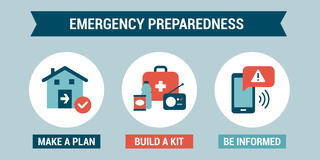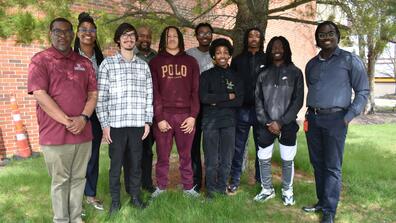Severe Weather and Flood Safety Awareness Week: A guide to preparing for severe weather

Campus-wide tornado drill set for April 3
As we transition into the spring and summer, Ohio's landscape comes back to life with warmer temperatures and vibrant colors. However, with the changing season also comes the possibility of severe weather conditions such as high winds, floods, and tornadoes.
To help keep you safe, you must prepare and know what to do in an emergency. One crucial step is understanding the difference between a "watch" and a "warning." A watch means that conditions are favorable for severe weather, while a warning means that severe weather is imminent or already occurring.
To mark the 50th anniversary of the devastating 1974 tornado that hit Xenia and the Central State University campus, Central State will host a campus-wide tornado drill from 1:30-2 p.m. April 3. This drill will allow students, faculty, and staff to practice their emergency response procedures and ensure they are prepared for a real emergency.
At Central State University, we take the safety and security of our community members seriously. We have an extensive plan to respond to any emergency situation that may arise due to human actions or natural events. Our dedicated team at the Office of Campus Police and Emergency Management works together with local and federal law enforcement agencies to stay on top of any situation that could potentially impact the University.
Whether it's a local incident or an international event, rest assured we're always working to keep our community safe.
By staying informed and taking steps to prepare, you can help ensure your safety during severe weather events. Remember to always prioritize your safety and seek shelter immediately if a warning is issued or if you see signs of severe weather.
The campus police department offers a comprehensive list of emergency procedures specific to the University.
How can I prepare for weather emergencies in Ohio?
When disaster strikes, having a plan can mean the difference between safety and injuries. According to the U.S. Department of Homeland Security’s Ready program, you should be aware of the types of disasters that could affect your area. Consider the following questions:
-
How will I receive emergency alerts and warnings?
-
What is my shelter plan?
-
What is my evacuation route?
-
What is my family and friend communication plan?
-
Do I need to update my emergency preparedness kit?
Emergency alerts
The Central State University Police Department offers the emergency communication app Alertus for the campus community. Emergency procedures can be found on the Central State website.
Alertus
The Alertus Recipient app allows students, faculty, and staff to receive push notifications from the Central State University alerts system using WiFi and cellular signal. You can find it on the App Store or Google Play. Follow the steps below to set it up on your device.
-
Download the app
-
Enter the organization code “CSU”
-
Enter your email address
-
IMPORTANT: Allow push notifications and location services
-
Navigate to Subscriptions
-
Subscribe to one or more of the following groups:
-
CSU Student/Faculty/Staff
-
Community/Parents
-
Create your profile
-
Click on the Settings icon at the bottom, right corner of your screen
-
Click on the icon showing a person at the top, right corner of your screen
-
Add your full name, phone number, date of birth, and CSU ID number under Emergency Notes
-
Add information that first responders should know about you, such as allergies and other health conditions
For more details, see the Alertus Recipient App for Android Installation and Registration/Guide or the Alertus Recipient App for iPhone Installation and Registration/Guide.
You can also find frequently asked questions at https://www.centralstate.edu/alertus.
When developing your plan, consider your specific needs. Factors may include the following:
-
Your age
-
Responsibilities for assisting others
-
Locations frequented
-
Dietary needs
-
Medical needs including prescriptions and equipment
-
Disabilities or access and functional needs, including devices and equipment
-
Languages spoken
-
Cultural and religious considerations
-
Service animals
You can make a plan using the federal Ready online tool. While it was created for family plans, you can use the form as a guide for your individual or room/apartment plan.
Other emergency communications and tools
The Ohio Committee for Severe Weather Awareness offers a list of local mass notifications systems and various preparedness tools to help keep you safe.
At Central State University, we understand the importance of feeling safe and secure on campus. That's why we're committed to providing all students, faculty, staff, and visitors with the necessary tools to protect themselves in case of emergencies.
Our top priority is your safety, and we want you to know that we're here to help.


